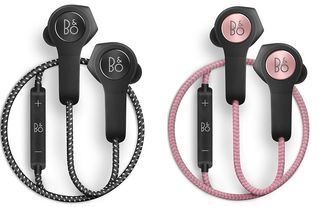B&O Play claims the BeoPlay H5 in-ear headphones deliver its signature sound out of the box, but a range of preset sound profiles can be selected using the accompanying Beoplay app. The app is available on Android and iOS smartphones, as well as the Apple Watch.
When not in use, the in-ears can be hung around your neck and, thanks to built-in magnets in both earpieces, they will stick together. When connected, they automatically power down to save battery life.
The interconnecting cable has a braided textile finish and is moulded directly into the rubber. This, says B&O Play, helps prevents sweat from interfering with the electronics inside. The earpiece housings are also made of moisture-resistant materials.
Jakob Wagner, designer of the Beoplay H5s says the in-ears have been “meticulously tested and improved to get the perfect fit”. In theory you should have no problem using them, no matter what your ear shape.
MORE: B&O BeoPlay H8 review

Inside the earpieces B&O Play has fitted 6.4mm dynamic drivers with small electromagnetic transducers and a wireless Bluetooth 4.2 chip with digital sound processing. The standard sound profile has been tuned by the company's engineers, but you can adjust it using the B&O Play ToneTouch interface.
The sound setting you choose is stored until the next time you change it. From the app, you can also see the remaining battery life, as well as control music playback and perform software updates.
The built-in 100mAh battery offers a claimed five hours of playback. To recharge, simply place them into the included cubic charging cradle. The H5s also come with seven pairs of ear tips.
The Beoplay H5 in-ear headphones are available in black and dusty rose finishes, priced £199.
